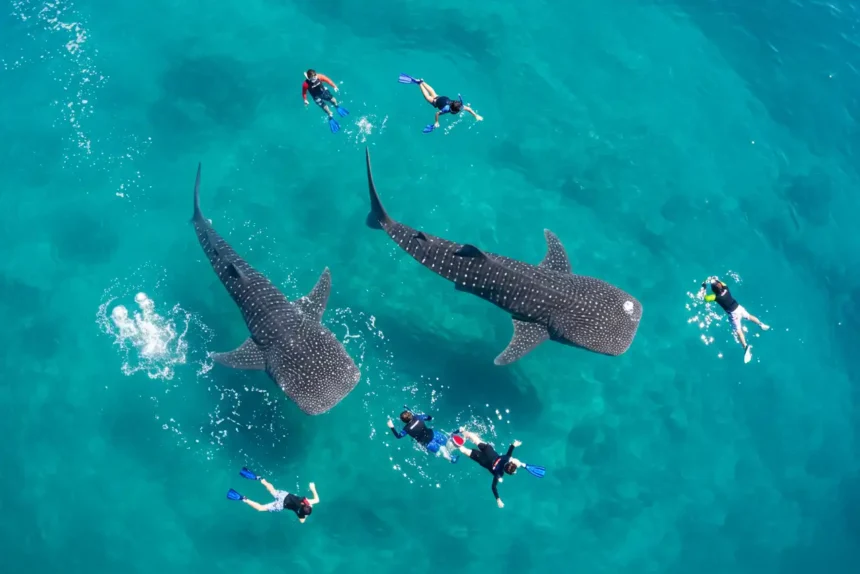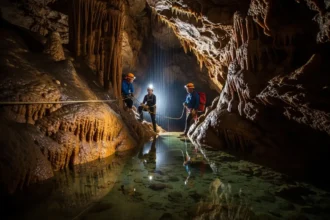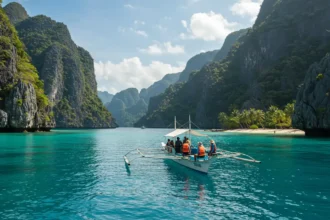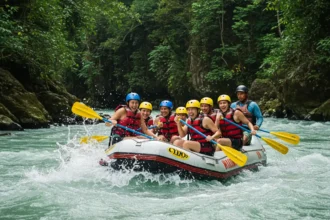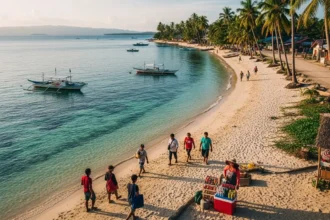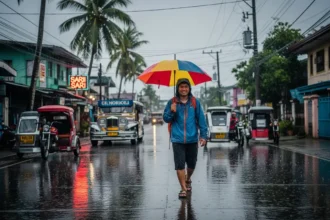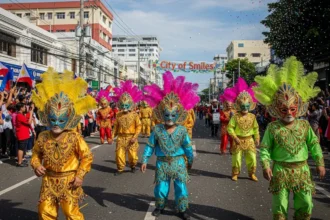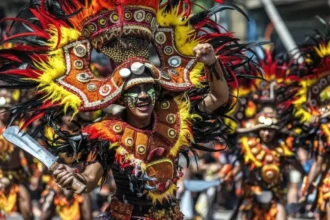There’s something magical about seeing a butanding glide beside you – massive yet gentle, like a living submarine with spots that shimmer under the Cebu sun. 🐋 For many travelers, the Oslob whale shark experience is a dream come true. Pero ayun nga… the dream also comes with questions. Is it ethical? Safe ba for the whale sharks? Worth it ba talaga?
- 🌊 How the Oslob Whale Shark Experience Works
- 🗓️ Best Time to See Whale Sharks in Oslob
- 🧭 How to Get to Oslob, Cebu (and Travel Tips for First-Timers)
- 🐋 The Ethics Debate: Is the Oslob Whale Shark Experience Ethical?
- 🏝️ Side Trips and Hidden Gems Near Oslob
- 💰 Budget Breakdown: How Much You’ll Spend for the Oslob Whale Shark Experience
- 🌅 Responsible Travel Reminders Before You Leave Oslob
- ❓ Frequently Asked Questions About the Oslob Whale Shark Experience
- 🌺 Leaving Oslob, Carrying Its Heart
If you’ve ever scrolled through Instagram and thought, “Gusto ko rin ma-experience ‘yan,” this guide is for you. We’ll walk you through everything – from the best time to see whale sharks in Oslob, to eco-friendly travel tips that let you enjoy responsibly. Kasi yes, you can make unforgettable memories without harming the ocean’s gentle giants.
So, ready ka na bang makipag-eye contact sa isa sa pinaka-majestic creatures sa mundo? Let’s dive in – literally and figuratively – and make sure your Oslob trip leaves only footprints, not regrets.
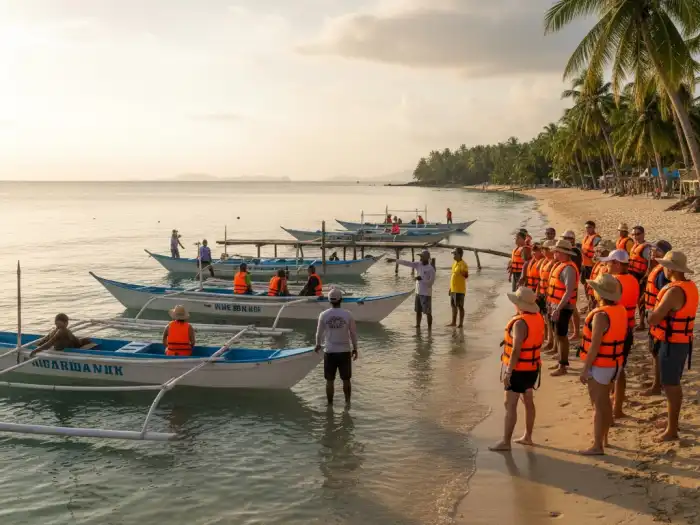
🌊 How the Oslob Whale Shark Experience Works
Imagine this: it’s 6 AM in Oslob, the sea still calm, and the air filled with quiet excitement. Dozens of tourists, both local and foreign, gather near the shore – clutching snorkel masks and life vests – ready to meet Cebu’s most famous residents: the Oslob whale sharks.
The process is pretty organized. Visitors register first, pay the whale shark tour price in Oslob, and then attend a short orientation. This briefing is super important – it explains what to do (and what not to do) when swimming with these gentle giants. Locals call them butanding, and for years they’ve been the heart of whale shark watching in Cebu.
Once your name is called, you’ll ride a small paddleboat heading a few meters offshore. The Oslob whale shark experience usually lasts around 30 minutes per group. The fishermen – or “feeders” – toss small amounts of krill to attract the whale sharks closer to the surface, giving visitors a rare chance to see them up close. Some people snorkel; others just stay on the boat to observe. Either way, the sight of a 12-meter-long butanding gliding under your feet is unforgettable.
But here’s the catch (no pun intended): because of this feeding practice, Oslob has also faced controversy. Many travelers wonder, is the Oslob whale shark experience ethical? Conservationists worry that constant feeding changes their natural migration and feeding behavior. Kaya kung pupunta ka, be a responsible visitor. Follow all rules – no touching, no flash photography, and keep at least a 4-meter distance.
If you want to enjoy this adventure guilt-free, remember: eco-friendly travel in Oslob starts with awareness. Don’t encourage operators who ignore guidelines, and always respect local marine life. The ocean is their home – we’re just lucky guests.
💡 Go With Guides Who Care
Not all tour providers are equal. Some smaller outfits cut corners or skip the safety briefing (delikado ‘yan!). When planning your Oslob whale shark tour, look for accredited organizations under the Oslob Tourism Office or Department of Tourism (DOT). They ensure proper briefings, ethical practices, and local guides who genuinely care for marine welfare.
| Type of Tour | Average Price | Includes |
|---|---|---|
| Local Tourist | ₱500–₱700 | Boat ride, life vest, briefing |
| Foreign Tourist | ₱1,000–₱1,500 | Boat ride, snorkel gear, guide |
| Add-on Package | ₱2,000+ | Whale shark + Tumalog Falls side trip |
Prices may change slightly depending on the season, but all tours include a safety orientation and mandatory life vests.
So if you’re planning your Oslob whale shark encounter, invest in the right operator. Minsan, the cheapest option isn’t the best – lalo na if it risks the well-being of these amazing creatures.
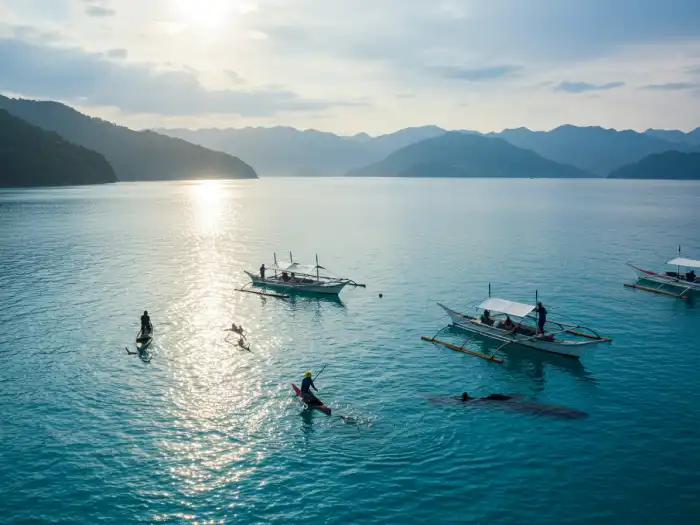
🗓️ Best Time to See Whale Sharks in Oslob
If there’s one thing about the ocean – it runs on its own schedule. And when it comes to the Oslob whale shark season, timing can make or break your trip.
The good news? Unlike other spots in the country, you can see whale sharks in Oslob Cebu almost all year round. Yup, rain or shine, these gentle giants visit the waters of Tan-awan, Oslob, thanks to the fishermen’s early morning feeding routine. But of course, some months are better than others.
🌤️ When the Sea Is at Its Calmest
The best time to see whale sharks in Oslob is between December and May, during the dry season. The water is clearer, the skies are blue, and visibility underwater is amazing. You’ll want that sunlight streaming through the surface – trust me, it makes the whale shark’s spot patterns sparkle like stars.
Early mornings are your best bet, ideally around 6:00 to 9:00 AM. After that, the sun gets harsher, and the waves can pick up. Plus, whale sharks tend to move deeper once the crowd builds. Kaya kung gusto mo ng serene encounter, wake up early (as in 4 AM early if you’re coming from Cebu City).
☔ Rainy Months, Risky Moves
Between June and November, you can still go, but expect some cancellations due to strong winds or big waves. The whale sharks are usually still around, but water clarity drops. If you’re traveling far just for this, mas okay na to plan it within the dry months para sulit ang biyahe mo.
| Season | Months | What to Expect |
|---|---|---|
| Dry Season | Dec–May | Best visibility, calm sea, high chance of sightings |
| Wet Season | Jun–Nov | Fewer tourists, murky water, unpredictable weather |
🐋 Cebu vs. Donsol: Which Has the Better Season?
If you’ve heard of the Donsol whale shark season, that’s usually from November to May – roughly similar timing. The difference? Donsol doesn’t feed them, so sightings there are seasonal and more natural. In contrast, the Oslob whale shark experience is almost guaranteed, but it’s also what makes people question its ethics.
So it’s really a matter of values. If you want a 99% chance of seeing whale sharks and you’re okay with the controlled setup, Oslob delivers. If you want something more raw, unpredictable, and wild – Donsol might be your calling. Either way, both remind us how incredible Philippine marine life truly is.
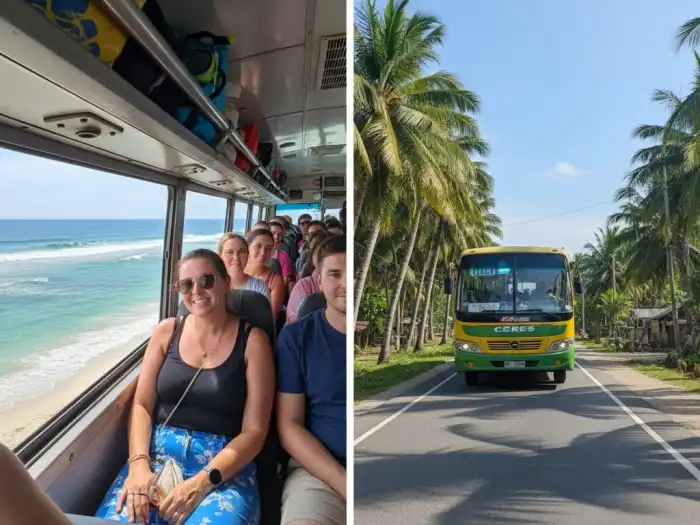
🧭 How to Get to Oslob, Cebu (and Travel Tips for First-Timers)
Reaching Oslob, Cebu feels like a small adventure on its own – part long drive, part scenic road trip by the sea. Whether you’re coming from Cebu City, Dumaguete, or even Bohol, it’s worth every kilometer. The views, the coastal breeze, and the anticipation of meeting the butanding… grabe, it builds up the excitement.
🚐 From Cebu City: The Classic Route
Most travelers start from Cebu City, hopping on a Ceres bus bound for Oslob at the South Bus Terminal. The ride takes around 3 to 4 hours, depending on traffic (and how many stopovers your bus decides to take, haha). Just tell the conductor you’re getting off at Tan-awan, the exact barangay where the Oslob whale shark encounter happens.
You can also rent a private van if you’re traveling as a group – mas convenient, less hassle, and you can stop by Tumalog Falls or Sumilon Island on the way back.
| Option | Travel Time | Cost (One Way) | Notes |
|---|---|---|---|
| Bus (Ceres) | 3–4 hrs | ₱200–₱250 | Budget-friendly, reliable |
| Private Van | 2.5–3 hrs | ₱3,000–₱4,000 | Best for groups/families |
| Motorcycle (rental) | 3 hrs | ₱700–₱1,000/day | Adventurous, scenic ride |
⛴️ From Dumaguete or Bohol: The Island Hoppers’ Way
If you’re coming from Dumaguete, take a short ferry to Liloan Port, then ride a tricycle or bus straight to Oslob. Super dali lang, about 30–45 minutes travel time total. From Bohol, ferries go to Cebu City or sometimes directly to the southern ports, depending on the operator.
No matter your route, don’t forget your essentials – waterproof bag, rash guard, underwater camera, and of course, patience (lalo na if you’re commuting).
🧳 The Smart Traveler’s Checklist
Before you even jump in the water, here’s a quick list of what to bring for your Oslob whale shark experience – practical stuff you’ll thank yourself for later:
- Rash guard or swimsuit (sunscreen isn’t allowed before swimming – it harms the sharks!)
- Waterproof pouch or dry bag for your phone and cash
- GoPro or waterproof camera (selfie lang, no flash, ha)
- Eco-friendly toiletries – small thing, big difference
- Extra clothes and towel (trust me, you’ll be soaked but happy)
And please, always choose eco-friendly travel in Oslob. Dispose of your trash properly, avoid touching marine life, and don’t buy plastic souvenirs near the shore. Be that traveler who leaves the ocean better than they found it.
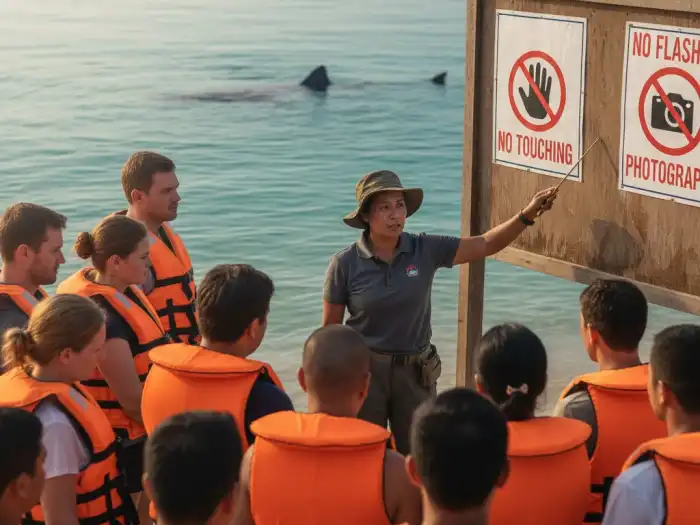
🐋 The Ethics Debate: Is the Oslob Whale Shark Experience Ethical?
Now here’s where things get a little tricky. The Oslob whale shark experience has put this small Cebuano town on the world map – and brought in thousands of tourists each month. Pero with fame comes controversy. Many travelers ask the same burning question: is the Oslob whale shark experience ethical?
Let’s unpack that honestly.
🌾 The Good Side: Livelihood and Awareness
Before the tours began, many fishermen in Oslob struggled to make a living. When whale sharks started appearing near their boats, the locals saw an opportunity. Instead of hunting them – which used to happen decades ago in other regions – they chose to protect them and earn through tourism instead.
Because of this, families in Tan-awan now have steady income. Kids go to school. Locals learn to speak English for tourists. The town flourishes. In a way, the Oslob whale shark tours helped raise awareness about these gentle giants. People who once feared the ocean now admire it. That’s a big win, diba?
⚖️ The Other Side: When Tourism Crosses the Line
But there’s also the downside – the reason conservation groups speak up. The feeding practice that keeps whale sharks close has changed their natural behavior. Instead of migrating freely, some have learned to rely on humans for food. That’s where the ethics debate starts.
Whale sharks are wild animals. When we feed them daily and surround them with boats, it can mess with their instincts – their navigation, their diet, even their breeding patterns. Some also suffer from small boat injuries when tourists get too close. Kaya please, whale shark safety tips exist for a reason:
- Never touch or chase them (kahit sobrang tempting)
- Keep at least 4 meters distance
- Don’t wear sunscreen before entering the water
- Avoid splashing or making loud noises
- Always listen to your guide
Those small things? They make a big difference.
🌊 The Way Forward: Responsible Encounters
If you truly love marine life, the goal isn’t to cancel Oslob – it’s to make it better. Choose operators who follow eco-friendly travel in Oslob guidelines, respect feeding limits, and support local education programs about ocean conservation.
Remember, you’re entering their home. The ocean doesn’t owe us a show. The Oslob whale sharks are not performers; they’re living, breathing reminders of how rich and fragile our ecosystem is.
So when you swim beside one – that quiet moment, that eye contact – let it move you. Not to take another selfie, but to protect what you’ve just witnessed. Kasi at the end of the day, real travelers don’t just collect photos. They collect purpose.
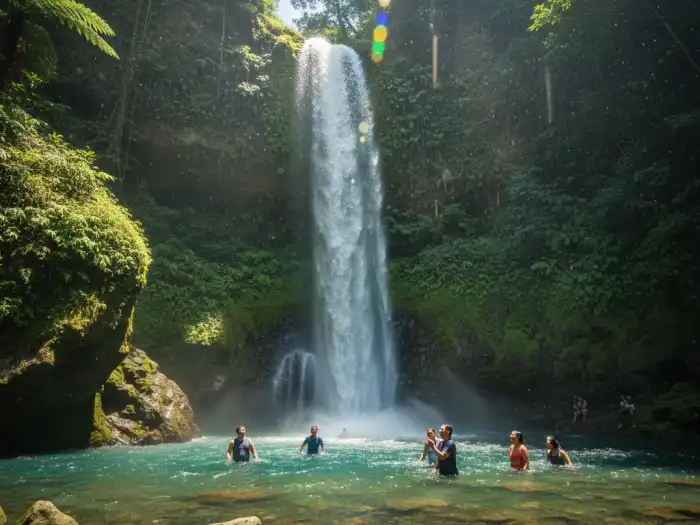
🏝️ Side Trips and Hidden Gems Near Oslob
Let’s be real – once you’ve done your Oslob whale shark encounter, it’s hard to top that feeling. Pero wait, don’t rush home just yet! The southern part of Cebu is a goldmine of beauty. Think waterfalls, islands, and old churches that whisper stories from centuries past. Your Oslob whale shark guide doesn’t end at the beach – it’s just getting started.
💦 Tumalog Falls – A Misty Blue Paradise
Only 15 minutes away from the whale shark site lies Tumalog Falls, one of the dreamiest waterfalls in the Visayas. The ride up is steep, but once you reach the top, ay grabe – surreal. The water cascades like a thin curtain, creating a misty blue pool below. Locals call it the “mini-Kawasan,” but honestly, it has its own charm.
Tip: hire a habal-habal (₱50–₱70 each way) and go early morning before the crowd hits. Bring slippers – the rocks can get slippery, and your toes will thank you.
🏝️ Sumilon Island – White Sand Escape
If you still have energy (and budget 😅), hop on a boat to Sumilon Island, about 15–20 minutes away. The island is famous for its sandbar that changes shape with the tides – parang mood swings ng dagat. It’s part of a marine sanctuary, so bring your snorkel and explore coral gardens teeming with fish.
Boat transfers cost around ₱1,500–₱2,000, depending on your group size. If you’re joining a resort tour, they usually include lunch and island activities.
🕍 Cuartel Ruins & Oslob Heritage Church
For something chill and cultural, swing by the Cuartel Ruins – an unfinished Spanish barracks made of coral stones. It’s right beside the Immaculate Conception Church of Oslob, which dates back to the 1800s. Perfect for history buffs, IG addicts, or anyone who loves that rustic seaside vibe.
You’ll realize – whale shark watching in Cebu is just one chapter of the story. The rest of Oslob tells tales of resilience, faith, and quiet beauty.
🐠 A Quick Map for Your Mini Itinerary
| Attraction | Distance from Whale Shark Site | Recommended Time |
|---|---|---|
| Tumalog Falls | 15 mins | 1–2 hours |
| Sumilon Island | 20 mins (by boat) | Half day |
| Cuartel Ruins & Church | 10 mins | 30 mins |
So yeah – don’t just tick “butanding” off your list and bounce. Stay a little longer, eat local food (their lechon belly hits different, promise), and chat with the people. That’s where the real magic of eco-friendly travel in Oslob begins – in the slow moments, not the selfies.
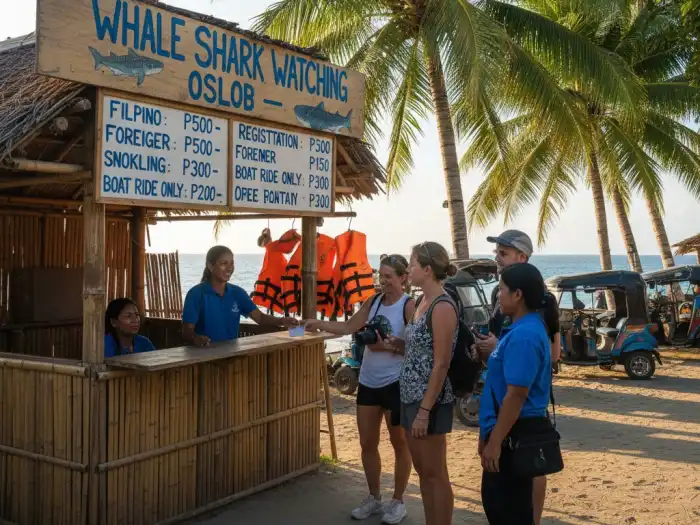
💰 Budget Breakdown: How Much You’ll Spend for the Oslob Whale Shark Experience
Before you dive into that once-in-a-lifetime swim, let’s talk numbers. Kasi kahit once-in-a-lifetime, dapat budget-friendly pa rin, diba? Here’s a quick rundown of how much the Oslob whale shark experience really costs – from fees to food to those tiny “ay-nakalimutan-ko-magdala” extras.
🧾 Main Fees and Inclusions
Official whale shark tour prices in Oslob depend on whether you’re local or foreign:
| Type of Visitor | Fee | Inclusions |
|---|---|---|
| Local Tourist | ₱500–₱700 | Boat ride, life vest, briefing |
| Foreign Tourist | ₱1,000–₱1,500 | Boat ride, snorkel gear, guide |
| Add-on Packages | ₱2,000+ | Tumalog Falls or Sumilon Island combo |
These rates already include the mandatory safety orientation and a local guide. But take note – bringing your own snorkel gear won’t give you a discount, haha.
🍽️ Meals, Transportation & Extras
- Meals: ₱150–₱300 (simple beachside eatery meals or “sugba-sugba” lunch)
- Bus from Cebu City: ₱200–₱250 one way
- Van rental: ₱3,000–₱4,000 round trip (perfect for barkada or family)
- Souvenirs: ₱100–₱500 depending on how much pasalubong mo gusto
If you’re staying overnight, budget around ₱1,000–₱2,000 for a decent guesthouse near Tan-awan.
🧳 What to Bring (and What Not To)
Trust me, forgetting the right stuff can turn an epic day into hassle central. So here’s your go-to checklist for what to bring to Oslob whale shark experience:
✅ Rash guard (no sunscreen before swimming – it’s harmful to whale sharks!)
✅ Waterproof bag or dry pouch
✅ Extra clothes and towel
✅ Drinking water (bring your own tumbler; avoid buying single-use plastic)
✅ Cash (some areas have weak signal for GCash)
❌ No lotions or perfume before swimming
❌ No food in the boat – it can attract fish and disrupt feeding
Following these makes you a true eco-friendly traveler in Oslob. Small choices, big impact sa kalikasan.
💡 Small Spends, Big Smiles
If you total everything – transport, food, fees, and a little lechon on the side – expect to spend around ₱1,500 to ₱3,000 per person for a full-day trip. Not bad for swimming beside the largest fish in the world, ‘no?
And here’s a mindset worth keeping: you’re not just paying for a photo-op. You’re supporting local livelihoods and ocean conservation. Each peso spent wisely can help Oslob thrive without harming its gentle giants.
🌅 Responsible Travel Reminders Before You Leave Oslob
You’ve met the giants. You’ve felt that quiet awe underwater – the moment when time slows, and a butanding glides beside you like a living constellation. Ang ganda, ‘di ba? But before you pack up and head home, here’s a gentle reminder: what you do after your Oslob whale shark experience matters just as much as what you did in the water.
🧡 Respect the Locals and the Ocean
Remember that this community lives and breathes the sea. Every peso you spend on local guides, eateries, and homestays helps them keep protecting the whale sharks of Cebu. Support businesses that follow eco-friendly travel in Oslob – those who refuse plastic straws, run beach clean-ups, or stick to proper feeding schedules. Small gestures like tipping your guide or saying salamat po go a long way.
And please, never litter. Not in the water, not on the road. A single plastic wrapper might end up in the ocean where these gentle giants feed. Walang forever sa selfie, pero may forever sa plastic, promise.
🏝️ Travel Light, Leave Lighter
Take memories, not sand. Leave footprints, not trash. That’s the golden rule. After all, whale shark safety tips aren’t just for the water – they’re a lifestyle. From using reef-safe products to choosing reusable bottles, every mindful act adds up.
When you leave Oslob, think of it as a friendship you’ll want to keep pure. Because one day, maybe you’ll bring your kids here, and you’d want them to see the same thriving sea – not a damaged one.
🌺 Gratitude and Goodbyes
Standing by the shore, watching the morning boats head out again, it hits you: travel isn’t just about going places. It’s about becoming someone new – more aware, more respectful, more alive.
So as you wave goodbye to Oslob, whisper a thank-you to the sea. You’ve just witnessed something rare – nature at its gentlest, humans at their most curious. Protect that feeling. Carry it wherever you go next.
❓ Frequently Asked Questions About the Oslob Whale Shark Experience
1. What is the best time to see whale sharks in Oslob?
The best time for the Oslob whale shark experience is from December to May, when the sea is calm and clear. Whale sharks visit year-round, but mornings offer the best visibility. Aim for 6 AM to 9 AM before the crowd builds up.
2. Is the Oslob whale shark experience ethical?
It’s a debated topic. Feeding practices keep the whale sharks near shore, which can affect their behavior. To travel responsibly, choose eco-friendly Oslob tour operators that follow feeding limits and safety guidelines.
3. How much is the whale shark tour price in Oslob?
For locals, it’s around ₱500–₱700, and for foreign visitors, ₱1,000–₱1,500, which includes the boat ride and life vest. Add-on tours like Tumalog Falls or Sumilon Island range from ₱2,000 and up. Always confirm the official whale shark tour prices in Oslob with accredited operators.
4. How do I get to Oslob from Cebu City?
Ride a Ceres bus from the South Bus Terminal bound for Oslob – about 3 to 4 hours. You can also hire a private van for faster travel or join group tours. Just tell the conductor to drop you off at Tan-awan, the whale shark site.
5. What should I bring for the Oslob whale shark experience?
Pack a rash guard, towel, waterproof bag, and extra clothes. Skip sunscreen before swimming – it’s harmful to marine life. Bring cash and a reusable water bottle for an eco-friendly travel Oslob experience.
6. Can I touch or swim too close to the whale sharks?
No. Always keep at least 4 meters distance and never touch or chase them. Following these whale shark safety tips protects both you and the animals.
7. What time do the whale shark tours in Oslob start?
Tours begin around 6:00 AM and usually end by noon. Whale sharks move deeper when the sun gets hotter, so earlier is always better. Arrive before sunrise if you’re coming from Cebu City.
8. Is there a whale shark season in Cebu similar to Donsol?
Yes, but Oslob’s season is year-round due to daily feeding, unlike Donsol whale shark season, which runs from November to May. Donsol offers a more natural encounter, while Oslob guarantees higher chances of sightings.
9. Are kids allowed to join the whale shark tour in Oslob?
Yes, kids can join as long as they wear life vests and are supervised by an adult. The experience is generally safe, but parents should ensure children follow the whale shark watching Cebu guidelines.
10. How can I make my Oslob trip more sustainable?
Support local eco-lodges, refuse single-use plastics, and pick tour operators with ethical practices. Practicing eco-friendly travel in Oslob helps protect the whale sharks and ensures future generations can experience them too.
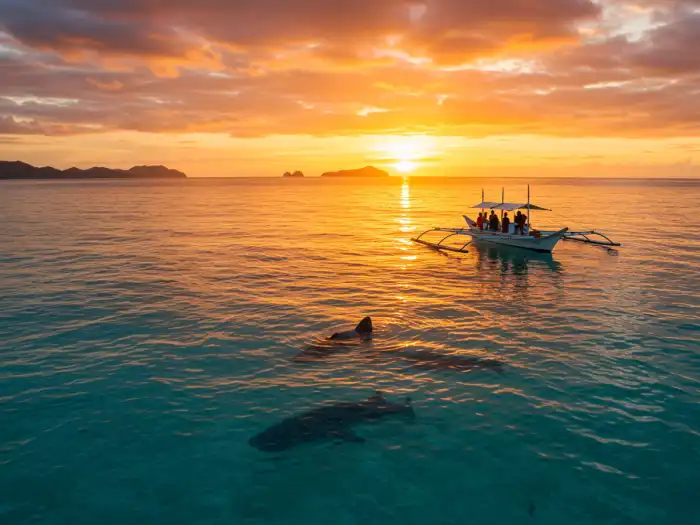
🌺 Leaving Oslob, Carrying Its Heart
You’ll never forget the first time you see it – that giant shadow emerging from the blue, the calm power of a whale shark gliding beneath you. The Oslob whale shark experience isn’t just a tourist activity; it’s a reminder of how small we are beside nature, and how much we owe it to protect what’s left.
If you travel here, do it with heart. Let the sea teach you humility. Let the locals show you kindness. Practice eco-friendly travel in Oslob not because it’s trendy, but because it’s the only way to keep this paradise alive. And when you finally head home – sun-tired, salt-skinned, and smiling – may you carry that quiet promise: to always leave the ocean better than you found it.
Because that, mga kababayan, is the real souvenir.
🧭 References
- Moalboal Eco Lodge – Is Oslob Whale Shark Watching Ethical?
- Animal Data Project – “A Guilty Pleasure”: Ethics of Feeding Whale Sharks
- Travel Muppetz – The Ethics of Swimming With Whale Sharks in Oslob
- National Geographic – Inside the Chaotic World of Whale Shark Tourism
- Beach Bum Adventure – What’s Wrong with the Oslob Experience



